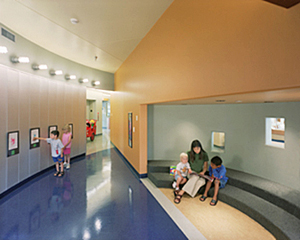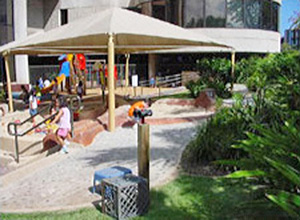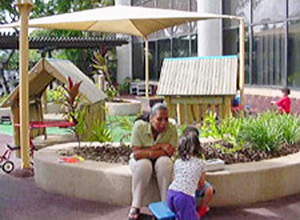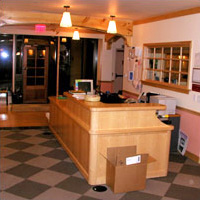Overview
Within This Page
While their parents work, seven out of ten American children under the age of six participate in some form of care outside the home. Because many of them spend up to 12,500 hours in a child development center—most of their waking hours—the facility must be designed to provide safe, nurturing, and stimulating environments essential for the healthy development of our children.
WBDG accepts the majority view that all child development centers should stress quality care, and child growth and development. To this end, all child development centers are encouraged to provide well-illuminated, active and passive activity areas that accommodate a range of play and organized learning as well as serve the needs of adult staff and parents, and facilitate staff-child relationship building.
There are nationally recognized accreditation agencies, such as the National Association for the Education of Young Children (NAEYC), that identify requirements for quality child development programs and facility conditions, including safety, sanitation, natural daylight, and classroom size.
Building Attributes
While child development centers can take many forms—they can be stand-alone or part of some larger structure; they can be urban or rural; they can be large or small.
A. Types of Spaces
Child Development Centers will contain a variety of space types depending on the hours they are used, the age of the children attending, the number of children attending, and the setting for the center. Fundamental space types may include, but are not limited to, the following:

Hallway with reading niche at child development center in Des Moines, Iowa.
Photo Credit: Architects Wells, Kastner, Schipper
- Child-friendly classrooms
- Meeting or community space for children and adults
- Child-friendly and adult restrooms
- Outdoor and indoor play areas
- Office space for staff
- Meeting space for adults
- Clinic
- Food service space
- Storage space
- See also WBDG Space TypeChild Care
All child development centers should seek to:
B. Be Homelike
Like a home, a quality child development center is a place where children can:
- Relax and be themselves
- Have ample natural light in all spaces were children will spend time, especially the classrooms
- Have a sense of arrival and welcome upon entering the center for both children and parents
- Use indirect lighting as main ambient lighting to avoid a "commercial" flavor
- Feel and be safe and secure
- Find different places for different kinds of learning
- Work and play using different furnishings and varied lighting
- Avoid institutional, unnatural finishes and textures. Use natural finishes to the extent possible, emphasizing a "hand-made" appearance
- Have no sharp edges: ½" bull-nose on all exterior corners at child-level gypsum and trim typical. Integral bull nose corner beads are recommended
- See also WBDG Provide Comfortable Environments
C. Be Child-Sized
Preferably, facilities designed for children should have:
- Child-sized furniture appropriate to the specific age group served
- Ceiling heights should be varied, low enough for intimacy, and high enough to avoid a monotonous spatial experience
- Windows at children's level
- Doors, sinks, toilets, and water fountains that are "child friendly" and mounted at appropriate heights
- See also WBDG Functional / Operational
D. Encourage Autonomy
Child development centers should be designed to allow children to:
- Independently address bodily needs such as hunger, thirst, using the toilet, and sleep
- Set their own pace
- Choose activities and toys
- Choose their own friends and companions - or be alone
- Be active or still
- Create three-dimensional projects that are protected from destruction by everyday traffic through classroom space
- See also WBDG Promote Health and Well-Being
E. Invite Self-Expression
Such facilities are characterized by:
- Restraint in color and furnishings (e.g., neutral tones for backgrounds and ceilings, with warm colors for accents)
- Space for children's art, located at the children's eye level together with a well-thought out and safe way of hanging art and displaying three-dimensional projects
- Space for objects that children bring to share or that have special meaning
- Changing displays more than permanent graphics
F. Provide Space, Indoor and Outdoor Physical Activities
Child development centers should have playground and multi-purpose play space for inclement weather. These areas should allow:
- Running
- Playing ball
- Climbing, swinging, sliding, and balancing
- Storage of play items such as tricycles
- Access to nearby toilets
- Controlled access for maintenance


Playground areas at a child development center in Honolulu, Hawaii allow children to interact with their peers and explore their surroundings.
Photo Credit: Landscape & Playground Designers Moore Iacofano Goltsman (MIG)
G. Have Outdoor and Indoor Spaces for Nature
When possible, they should contain places to:
- Dig in dirt or sand
- Play with water
- Grow seeds, flowers, and vegetables
- Investigate animal life
- Collect rocks, leaves, or other specimens
- Contain a variety and scale of natural elements such as trees, flowers, and shrubs
- Have quiet time, away from the "crowd" while still being able to be supervised
- Places for large motor activities such as climbing and riding wheeled toys
- Storage shed(s) for storage of outdoor equipment
- Have a (typically) 6'–0" fence completely surrounding the play area
H. Be Structured, Yet Flexible
This means that different spaces in a facility:
- Can be recognized by children
- Are for quiet and active play
- Can be rearranged by children for their own activities
- Contain adequate storage facilities to avoid a chaotic impression
- See also WBDG Beyond Accessibility to Universal Design
I. Include Appropriate Space for Parents and Teachers
This includes places to:

Staff can monitor and control access to the child development center from desks positioned at the entry such as the one shown in the photo.
World Bank, Washington, DC
- Think and plan
- Meet and communicate
- Host visitors
- Store equipment
- Keep record
- Come together and celebrate as a community
J. Be Safe, Secure, and Healthy
This includes provisions and strategies to ensure that:
- Children are not abused by adults in the center
- People / personnel do not have uncontrolled access
- There are adequate washing facilities
- Finishes are easily cleaned
- Attention is paid to good indoor air quality as well as to the use of daylighting, non-toxic building materials and improved maintenance practices
- Equipment, furnishings, and finishes do not contain asbestos or lead
- See also WBDG Ensure Occupant Safety and Health
Relevant Codes and Standards
As the number of child development centers increases, more and more agencies, states, and municipalities are requiring that child development centers within their jurisdictions meet minimum facility and operating standards. However, in most states the facilities requirements are limited to relatively few and minimal health and safety issues such as the adequacy of bathrooms, egress, and lighting. The most comprehensive facilities standards available at present, sometimes cited in state and municipal codes, are those promulgated by federal agencies. Among the organizations that have led the way toward the definition of comprehensive child development centers criteria are the U.S. General Services Administration, Department of Health and Human Services, and the Department of Defense.
Federal Mandates and Criteria
- ADA Accessibility Guidelines for Building Elements Designed for Children's Use
- ADA Guide: Accessibility Guidelines for Play Areas
- Executive Order 13693, "Planning for Federal Sustainability in the Next Decade"
- UFC 3-210-04 Children's Outdoor Play Area
- UFC 4-740-14 Design: Child Development Centers (USACE and Air Force Only)
- FC 4-740-14N Navy and Marine Corps Child Development Centers
- UFGS 11 68 13 Playground Equipment
- UFGS 32 18 16.13 Playground Protective Surfacing
- VHA PG-18-9: Space Planning Criteria, Chapter 420 Childcare / Development Center
Standards and Guidelines
- Army TM 5-663 Child Development Center Play Area Inspection and Maintenance Program
- ASTM F355 Standard Test Method for Impact Attenuation of Playing Surface Systems, Other Protective Sport Systems, and Materials Used for Athletics, Recreation and Play
- Consumer Product Safety Commission, Public Playground Safety Handbook
- EPA Comprehensive Procurement Guidelines for Park and Recreation Products EPA
- Head Start Center Design Guide: A guide for building a Head Start Faciity , Department of Health and Human Services
- PBS-140 Child Care Center Design Guide, General Services Administration
- Property Manager's Child Care Resource Book , General Services Administration
Additional Resources
Organizations
- GSA Child Office of Child Care — The primary mission of GSA's Child Care Operations Center of Expertise is to ensure that federal families receive high quality care for their young children in child care centers located in GSA managed space.
- National Association for the Education of Young Children (NAEYC) — An advocacy organization for preschool care and education
- National Child Care Association (NCCA) — A trade association for private, for-profit child-care facility operators
- National Children's Facilities Network — A coalition of nonprofit financial and technical assistance intermediaries involved in planning, developing, and financing facilities for low-income child care and Head Start programs
Publications
- BIPS 07 / FEMA 428 Primer to Design Safe School Projects in Case of Terrorist Attacks and School Shootings
- Caring for Our Children, National Health and Safety Performance Standards: Guidelines for Out-of-Home Child Care Programs, 3rd Edition American Academy of Pediatrics, American Public Health Association, National Resource Center for Health and Safety in Child Care and Early Education. 2011.
- Child Care Design Guide by Anita Rui Olds. New York, NY: McGraw-Hill, 2000.
- Creating Environments for Learning: Birth to Age Eight, 3rd Edition by Julie Bullard. Pearson Education, 2017.
- Greening Early Childhood Centers by Mike Lindstrom and Amy Gillman. Local Initiatives Support Corporation/Connecticut Children's Investment Partnership, 2010.
- Play and Playscapes by Joe Frost. Albany, New York: Delmar Publications, Inc., 1992.
Other
- Infant/Toddler Environment Rating Scales, by Thelma Harms, Debby Cryer, and Richard M. Clifford. Frank Porter Graham Child Development Institute of the University of North Carolina at Chapel Hill. Revised Edition.








